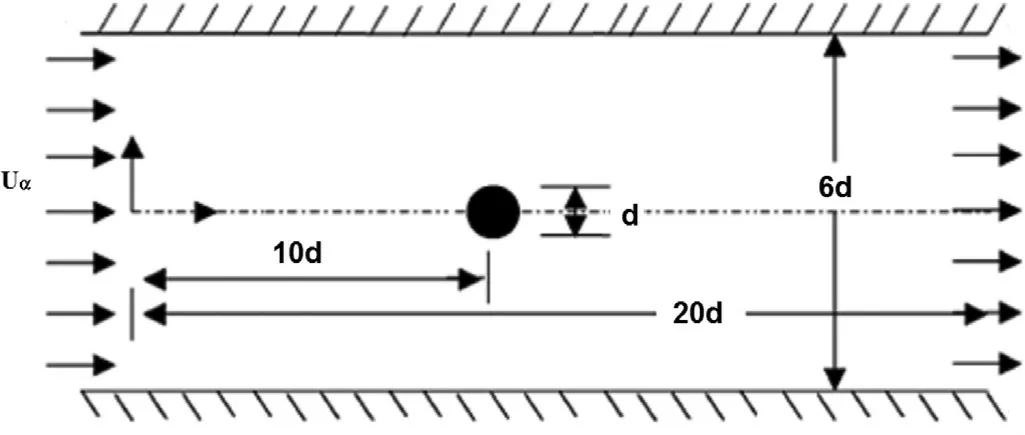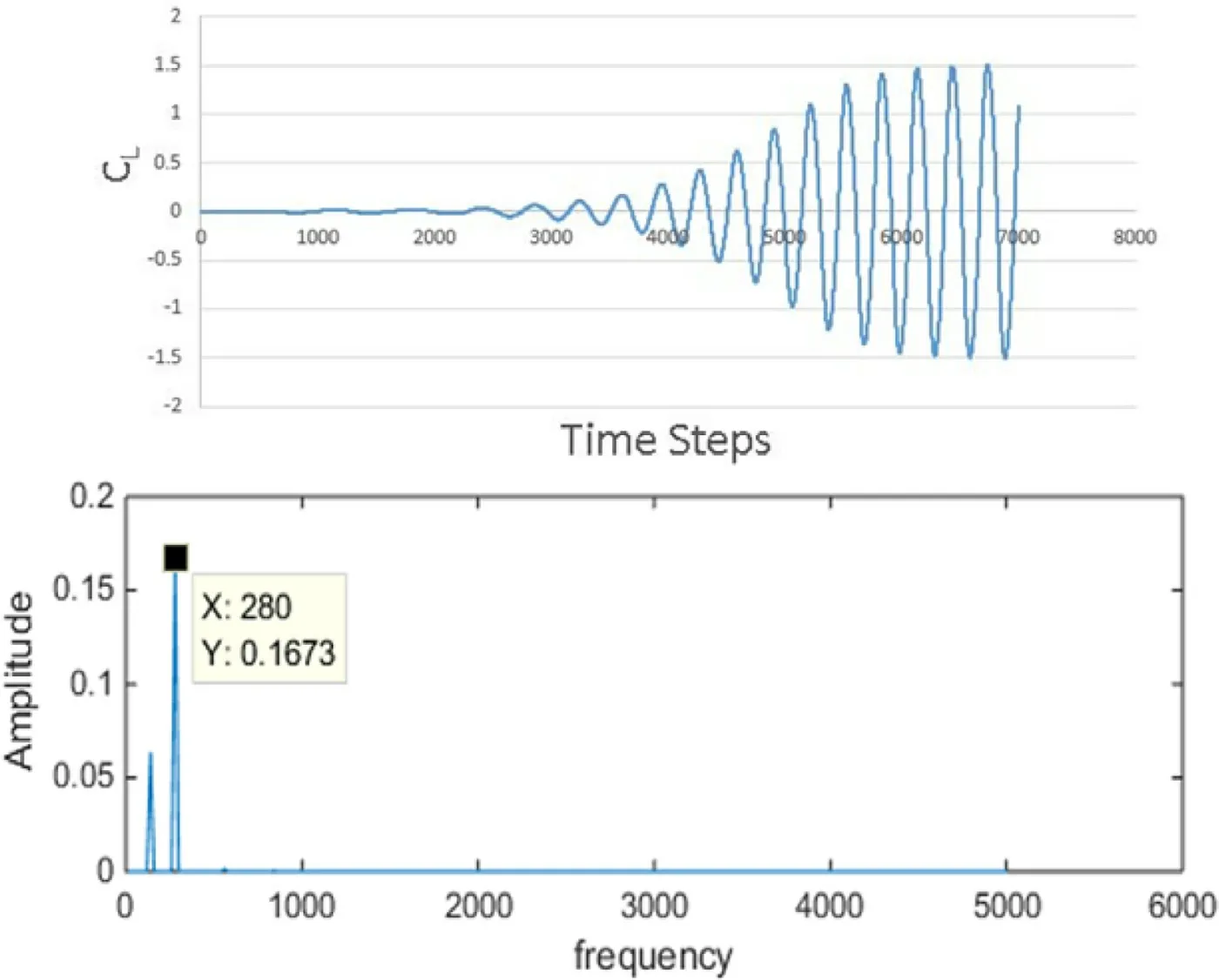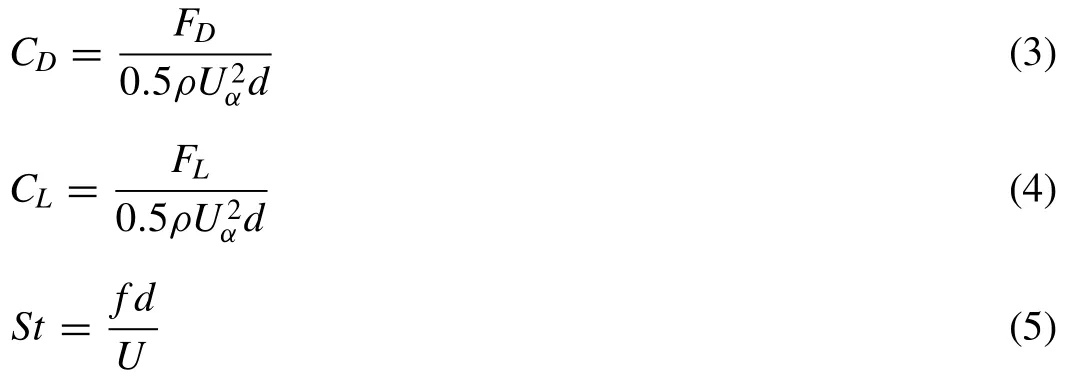Flow past a bluff body subjected to lower subcritical Reynolds number
Pankaj Kumar,Santosh Kumar Singh
Department of Mechanical Engineering ,SRM Institute of Science and Technology ,Kattankulathur 603203, India
Received 28 June 2019; received in revised form 30 September 2019; accepted 26 October 2019
Available online 1 November 2019
Abstract The paper aimed to study the flow structure at the wake of the bluff body with altered blockage ratio (BR) keeping the fixed aspect ratio(AR). The study was conducted by a finite volume technique using commercial software Ansys-Fluent. The CFD analysis of the bluff body is mainly subjected to the lower subcritical Reynolds number range (5000 to 15,000) along with blockage ratio as an important factor. The flow parameters such as drag coefficient,pressure,and kinetic energy variations are analyzed here for the Reynolds number ( Re) and BR. It was observed that at fixed Re, t he drag coefficient ( C D ) increases with an increase in the BR while decrease with increasing Re for a fixed value of BR.
Keywords: Blockage ratio; Bluff body; Drag coefficient; Reynolds number.
1. Introduction
The understanding of flow over bluff bodies has been a topic of substantial significance. It has implication to many engineering fluid flow situations in a different branch of engineering. The major characteristic of flow over the bluff body is the development of a turbulent wake with a recirculation,which has a principal effect on the drag acting on the bluffbody [1,2] . This type of flow structure is characterized by a flow separation zone,followed by turbulent eddies in the wake flow zone [3] . Roshko [4] categorized flow based on Reynolds number as subcritical (300<Re<3 × 105),critical(3 × 105<Re<3.5 × 105) and supercritical (Re>3.5 × 105).The difference in the flow pattern,separation angle,and drag coefficient occurring on the cylinder surface is the main reason for the distinctive features observed in each of these flow regimes. Obasaju [5] studied the effect of cylinder orientation at highReusing hotwire anemometry and suggested a reduction in drag coefficient at a lower angle of attack. Lee and Budwig [6] studied experimentally,the effect of AR for a circular cylinder at lowRe. They suggested that a different Strouhal number (Sh) value for AR>60 in the different range ofRe(64<Re<130). Szepessy and Bearman [7] studied the upshot of AR for flow past a cylinder at highReand suggested that the wake flow is 2D. The effect of AR for flow past a circular cylinder at a wide range of Reynolds numbers was studied by Norberg [8] . TheRewas varied from laminar to transition and finally turbulent flow. The constant vortex shedding was observed for AR>40 and was delayed for lower ARs. Also,at AR>100,theStwas observed to be sovereign of AR. The effect of the blockage was investigated numerically by Behr et al. [9] ,Anagnostopoulos et al. [10] and Turki et al. [11] . It is shown that with an increasing blockage,the Strouhal number and drag coefficient increase,while the base suction and stagnation pressure coefficients increase. Recently,Mallick and Kumar [12] suggested that the drag force increases with an increase in the diameter of the cylinder. Also,for a cylinder of a particular diameter,drag force has been found to increase with an increase in air velocity.

Fig. 1. Schematic of the computational domain.
In summary,a large amount of knowledge is accessible on the drag,vortex shedding,transition from one flow regime to another,etc.,little is known about the extent of blockage at lower subcritical Reynolds number on drag and wake characteristics for a circular cylinder. The present study is an attempt to investigate the effects of blockage ratio at lower subcritical Reynolds number range (5000-15,000). In the present study,the simulation is executed on a 2D mesh construction of the cylinder with varying blockage ratio having foremost anxiety for pressure,drag and kinetic energy analysis. The analysis of flow at the wake of the bluff body is done by an assortment of pressure,velocity intensity in 2D and turbulent kinetic energy intensity data up to 3 times the diameter of the cylinder especially at the wake of the cylinder. Aspect ratio,which is defined here as a ratio of the length of the cylinder in major axis to the length of the cylinder in minor axis,is also considered along with blockage ratio.
2. Numerical methodology
A two-dimensional incompressible transient flow over a circular cylinder is considered for the simulation. The flow is bounded by an asymmetric wall with inlet and outlet. The analysis is chosen at the center plane so only flow variables in stream-wise and normal to flow direction is considered.The governing equation will be reduced as follows [13] :

Since the Reynolds number falls in turbulent range soK-ω-SSTmodel is used which is found much accurate to predict lift,drag for circular cylinder by Rossetti et al. [14] .This turbulence model solves one transport equation for the turbulent kinetic energy,k,and one transport equation for the dissipation per unit kinetic energy,ω(details in Menter [15] ). Here the treatment of the proper viscous near-wall region and pressure gradients by resolving the blending the features of thek-εand thek-ω.
Fig. 1 represents the designed geometry based on which the mesh is generated for various test cases. Origin of the space is selected as the center of the cylinder for convenience in referring to wake region extent. The left part of the computational domain is inlet and right as an outlet. Top and bottom are assumed wall. To determine the cylinder diameter(d),three blockages (6,10 and 20%) of the flow region is considered here. For e.g.,in the case of 10% blockage,the diameter of the cylinder is 6 mm [ 60 ×d/(60 × 60)= 10% ] .The similar procedure was used for the calculation of diameter for the blockages 6 and 20% and the respective diameters are 3.6 and 12 mm [1] .

Fig. 2. (a) mesh and zoomed view near cylinder (b) y + value near cylinder.

Fig. 3. Typical mesh near cylinder is shown for different blockage ratio and aspect ratio.

Fig. 4. Monitor points created for surface reports.

Fig. 5. Time v ariation of C L and corresponding frequency for the blockage 6%,aspect ratio 1 at Reynolds number 15,000.

Table 1 Variations of C D and S t with several nodes Reynolds number 15,000.
The inlet velocity was determined by the respective Reynolds number,,where,L,Uandνare the characteristics length (diameter in case of the cylinder),inlet flow velocity and kinematic viscosity respectively. ForRe= 5000,the obtained velocities are 1.33,0.833 and 0.416 m/s based on cylinder aspect ratio for the BR = 6,10 and 20% respectively. Similarly,velocity variation was observed from 4.1 to 1.2 m/s with a change in BR 6-20%. The ICEM ANSYS software was used to create a 2D mesh for various cases. Closed to the cylinder,O-grid multi-blocks arrangement was adopted for creating the fine mesh around the cylinder. The developed structured 2-D mesh was exported for all conditions and simulated in ANSYS Fluent. A typical mesh along with a zoomed view near cylinder is shown in Fig. 2 (a). In Fig. 2 (b),y+plot is shown near cylinder which is less than 1. The various combination of aspect ratio and blockage ratio of cylinder mesh are shown in Fig. 3 for clarity. The boundary conditions are inlet,uniform flow (U= 1.0,V= 0.0),at the cylinder surface,no-slip (U= 0.0,V= 0.0,) top and bottom wall are no-slip wall condition and outlet boundary-continuative boundary condition can be expressed as (P= 0.0). Double precision computer number format option is selected which use 64-bit for each floating-point and hence increases precision.Pressure based type solver is chosen with transient time setup and absolute velocity formulation in planar coordinate system 2D space. The Points are created in the wake region behind the cylinder shape. Each point is created with an increment equal to that of the cylinder radius in bothx-andy-direction.Surface report definitions are created for extracting absolute pressure,turbulence kinetic energy,andx-velocity on these points in the wake region. Surface monitor window is shown in Fig. 4 . The calculation at each node point is done for a maximum of 200 iterations for the solution to converge over a time-lapse of 10-1order seconds unit by multiplying the number of time steps over a time step size of 0.0001.The root mean square (RMS) value for the 20 cycles,after reaching a steady periodic stage,is done to obtain the pressure,velocity and turbulent kinetic energy at each node.
The drag,lift coefficient,and Strouhal number is defined as follow:

where,(Uα) is the free stream velocity,FDandFLis the drag and lift forces,respectively. The coefficient of drag and lift(CDandCL) values calculated from the pressure coefficient over the cylinder surface.
2.1. Grid independence and validation
Latterly,many problems arising in different fields of science and engineering can be reduced,by applying some appropriate discretization and grid independence test [16,17] .In the present study,the mesh density was investigated to make sure that the obtained result did not depend on the mesh nodes. The mesh node,drag coefficient and Strouhal number(St)are presented in Table 1 for the grid-independent test.Further,the drag coefficient (CD) and Strouhal number (St)are chosen for validation with the published work of Benim et al. [18] and Norberg [19] . It was found a good matching between the values of the drag coefficient (CD) and Strouhal number (St). The mesh,at a minimum no of node at which theCDandCLare constant,was selected as a grid-independent mesh. It is founded that a mesh with 31,700 nodes is suitable for the present study. The lift variation with time step is shown in Fig. 5 for blockage 6% and aspect ratio 1 atRe15,000. Shedding frequency obtained through FFT is 280 which correspond to the Strouhal number of 0.21.

Fig. 6. Variation of pressure at a different location and Reynolds number keeping a fixed aspect ratio.

Fig. 7. Effect of blockage ratio on pressure variation at constant Reynolds number.
3. Result and discussions
Pressure variation is significant in the study of flow over the circular cylinder. Pressure varies accordingly with the vortices motion in the locality of the cylinder. Flow detaches alternately about symmetrical bodies to form vortices around the cylinder. This typically initiates intermittent energies on the body due to the pressure varies. This circumstance is mainly important inflow linking fluid and structure interaction such as the flow around a tall building or suspension bridge.Even though pressure persuaded force does not influence the simulation on a fastened cylinder very much. Vortex structure and evolution provoke forces on the bodies wrapped in the flow. A vortex produces a negative pressure suction area nearby to the surface where it progresses. Thus,the analysis of pressure variation is imperative in the study of the aerodynamic forces around a body. Therefore,Fig. 6 is provided to shows the variation of normalized pressure on the surface(x/r= 1,where r is the radius of the cylinder) and wake region(x/r= 2 and 3) of the cylinder. The intensity of pressure variation at the center (y= 0) is very low particularly at the surface forRe= 15,000. This is probably because the pressure allotment in the vicinity of the cylinder,flow energy is rather low due to viscous effects and thus,receptive to the amends of the pressure gradient. However,with low Reynolds number,the variation in pressure is uniform for all the selectedx-locations. Further,it is observed (y= 0) that on the surface of the bluff body pressure is low compared to the other two locations but it increases with the change in position along the y-direction.

Fig. 8. Variation of turbulent kinetic energy (TKE) at different BR keeping a fixed Reynolds number.

Fig. 9. (a) Variation of drag coefficient with different aspect ratio at BR = 6% (b) variation of drag coefficient with blockage ratio for aspect ratio 1.
Fig. 7 shows the variation of pressure intensity at different blockage ratio keeping fixed Reynolds number and aspect ratio. It is observed from Fig. 7 that at 6% blockage ratio the intensity of pressure is minimum particularly at a distance ofx= 2rand 3r. With the increase in blockage ratio,pressure intensity increases successively which is similar for all three locations.
Fig. 8 shows the variation of turbulent kinetic energy at different blockage ratio keeping fixedReand AR. The variation of turbulent kinetic energy is maximum atx=r,particularly at 6% of blockage. It is to be noted here that on the surface of the bluff body a clear double peak is observed in they-direction with equal in magnitude. With an increase in distance,the double peak value diminishes. It is also revealed from Fig. 8 that the TKE value decreases with an increase in blockage ratio as well as with increased distance from the bluff body.
Further examination of these results suggests that the drag force is maximum at low Reynolds number and it decreases with an increase in Reynolds number. Fig. 9 (a) shows the variation of the drag coefficient with different aspect ratio and Reynolds number. It can be seen from Fig. 9 that the drag coefficient gradually decreases with an increase in Reynolds at aspect ratio 0.75 and 1 and it becomes steady for aspect ratio 1.50. In fact,slight variation is observed at low aspect ratio with a change in the Reynolds number i.e.,it appears that at higher aspect ratio the effect of Reynolds number is insignificant at a particular location. Drag coefficient decrease with an increase in Reynolds number for each aspect ratio.Aspect ratio affects drag more prominently than Reynolds number. For aspect ratio 1.5 Reynolds number has an almost null effect and for that of aspect ratio,1 and 0.75 decrease gradient increases with Reynolds number. Fig. 9 (b) shows the variation of the drag coefficient for different blockage ratio.The drag coefficient decreases with Reynold number were increases with Blockage Ratio. At higher blockage,the wake becomes narrow and the separation angle increases. This leads to a higher value of the drag coefficient.
4. Conclusions
The objective is to study the flow characteristics numerically at the wake of the circular cylinder with different blockage ratio andRe. This study was made with the help of finite volume technique using commercial software ANSYSFLUENT at Reynolds number = 5000,10,000 and 15,000 along with blockage ratio as an important factor. The basic results lead to the following findings:
·It is observed that the drag coefficient,CDreduced with an increase inRefor a fixed value of aspect ratio.
·The lower magnitude of pressure which correlated with the wake zone of the cylinder is slowly diminished with an increase in BR.
·At AR = 1,the drag coefficient has a constant value especially for initial BR and thereafter,CDraises linearly with further enhance in BR.
·It was observed that pressure is well associated with mean TKE and it reorganizes the flow intensity.
Declaration of Competing Interest
The authors would like to declare that no potential conflicts of interest with respect to the research,authorship,and/or publication of this article.
Acknowledgment
Authors like to acknowledge to our student Aditya Sharma,student SRMIST to help in simulation work.
Funding
The authors received no financial support for the research,authorship,and/or publication of this article.
 Journal of Ocean Engineering and Science2020年2期
Journal of Ocean Engineering and Science2020年2期
- Journal of Ocean Engineering and Science的其它文章
- Analytic solutions of the generalized water wave dynamical equations based on time-space symmetric differential operator
- Solitary wave solutions for the variable-coefficient coupled nonlinear Schrödinger equations and Davey-Stewartson system using modified sine-Gordon equation method
- Comparison of computational fluid dynamics and fluid structure interaction models for the performance prediction of tidal current turbines
- Mathematical modelling and analysis of plastic waste pollution and its impact on the ocean surface
- An assessment of oil spill detection using Sentinel 1 SAR-C images
- Gimbal orientation study and assessment for the autonomous underwater vehicles
